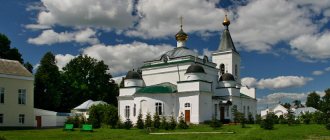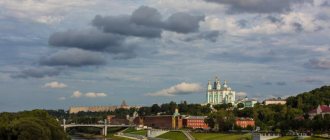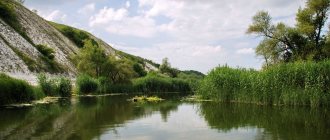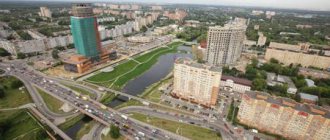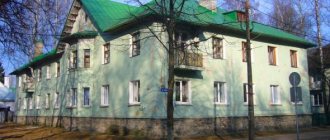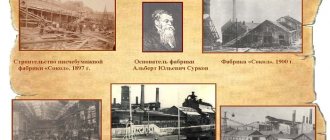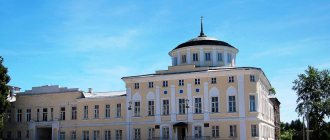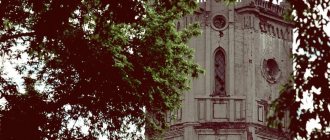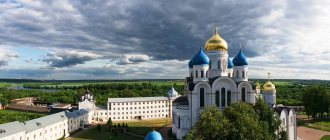The main attractions of Yartsevo
Any tourist, going on a trip, makes a list of attractions in Yartsevo that must be visited. Some are developing independent ways to get to know the city, while others prefer various walking or bus excursion tours. Traditionally, they capture the main attractions of Yartsevo and give an idea of the historical and cultural development of the city.
Admirers of creativity always strive to find sculptural attractions on the map of Yartsevo. In the central city squares you can usually visit classical sculptural compositions, against which city guests pose. But in popular parks you can see exhibitions of modern sculptures and art objects. They can be made from the most unexpected materials and represent incredible variations of different shapes that you will have to think about.
Among the main attractions of Yartsevo, religious sites play a special role. They form the architectural appearance of the city in Russia, some of them have an interesting and mysterious history. In Yartsevo and outside the city, you can visit monasteries known throughout the country, admire the elegant appearance of large Christian churches, or go to cozy and small chapels that are so popular among city residents.
While traveling around the area, you can also come across special religious sites. These could be national religious buildings, centuries-old places of worship, or generally mysterious places of power.
A great idea is walking around Yartsevo. You have a choice: buy a Yartsevo map with attractions and routes in advance, or simply wander where you like. This will make it even more exciting. Let yourself get lost in ancient alleys or wander through parks. And if you get tired, you can have a snack or drink a cup of coffee in a pleasant cafeteria. By the way, in Yartsevo there are a couple of famous places where every visitor to the city hopes to get to.
If you want to get the most complete picture of the city and its history, welcome to the Yartsevo museums. They will present you with extensive exhibitions on ethnology, painting, objects of folk art and everyday life, from archaeological expeditions. Traditionally, these attractions are located in the center.
At the same time, open museums dedicated to a specific topic can often be visited in suburban areas. They present interesting showrooms dedicated to national life and folk crafts. In addition, it could be a museum reconstruction of ancient settlements or defensive forts. These Yartsevo attractions will be interesting for children.
For tourists traveling with their families, the question always arises: where to go with children. The most popular answer is to go to one of the Yartsevo aquatic complexes. Often there are bonuses when ordering a day ticket for the whole family.
If you are traveling in winter or spring, we recommend considering the Yartsevo ski resorts for a fun pastime. This place has a wide variety of activities for children and adults: a variety of ski and snowboard slopes, snow tubing, and exciting snow parks for the pros. Usually such resorts can be found not very far from the city. So it’s easier to go there by personal transport or rent a car.
An excellent prospect for a family weekend is an outing into nature. Such attractions are located near Yartsevo. These can be reservoirs, gorges, famous nature reserves. You just need to choose a place. You can get to these corners of nature both by your own car and by public transport. Check in advance the schedule of minibuses running from suburban bus stations in the direction you need. In such an adventure you will get a lot of unforgettable memories from being in the fresh air, and you will put your mind and body in order.
If you came to the city on work matters, then you have little time for long excursion trips. In such a situation, we recommend purchasing a condensed guide to the sights of Yartsevo with photos and descriptions.
You can find it at any time upon arrival in the city at railway stations or at the airport. This guide provides a list of the most popular places to go in Yartsevo, with names and photos of attractions. Admittedly, this greatly simplifies the task of what to see in Yartsevo, especially if you have a tight time limit.
However, if the directory describes the most popular places in Yartsevo, then in the search network there is a chance to find the top little-known, but no less interesting attractions with reviews from experienced travelers. Abandoned mines, unusual quarries, unusual railway tracks, viaducts - such attractions attract lovers of adventure.
When planning a trip to Yartsevo, we recommend studying information not only about the attractions, but also about other city infrastructure facilities. For the convenience of moving around the city, it is important to imagine the routes of public transport, the location of railway and bus stations or ports, metro stations. At the same time, such important public buildings in Yartsevo can also attract the attention of travelers. Often they are the ones who form the first impression of a locality on a visitor’s part.
Show more
akuaku.ru
LiveInternetLiveInternet
Some 10 years ago I didn’t even know about this town. Later, it’s worth saying, I heard a lot, but it still wasn’t possible to visit here. Everything changed with the birth of children. North, north, but the children need to be taken out. The city is home to approximately 50,100 people, has production, architectural and museum values, picturesque nature and, most importantly, people living in it. Here's my story.
The first thing that catches your eye is the roads, or rather the lack thereof. And there is no need to talk about sidewalks along roads or in courtyards of houses. When such an event as a walk with a child without a stroller becomes like some kind of reality show with somersaults and, as a result, falls.
Most often we go for a walk to the “From and Do” store, which has installed a playground with a low slide, a sandbox and a swing, or to a square where there are absolutely no children’s play areas, except for a daisy painted on the asphalt. I like the cleanliness, spaciousness and lack of passing cars on these pieces of land. There is also a park where you can take a walk with your children without harm to your health.
And where can you actually go for a walk with your children? Two years ago I would undoubtedly have said in the apple orchard. At that time, I was very impressed by the proximity to the house, the cleanliness and, of course, the presence of metal, albeit not modern, but still serviceable swings and carousels. Now I don't think so. It is worth saying that even now people with and without children gather there, but most likely this is due to the stall standing on the site. In general, there is nothing to do there, and there is no need to talk about what happens there during the period of fruit ripening. A year ago, there was a perfectly acceptable site in the yard next to the Dixie store. Now these are broken, scribbled and broken slides, swings, and destroyed sandboxes. For the most part, this is the “credit” of the students of the school located next door.
If the theater begins with a coat rack, then cultural institutions, educational institutions and public catering establishments here, oddly enough, begin with garbage dumps. The situation in the city is sad with regard to garbage disposal, which is found both in spontaneous and in specially designated places.
I often wonder what kind of aesthetics children can learn if in front of the main entrance of school No. 1 a huge mountain of garbage is visible every day, and a bustling market is visible from the windows.
The premises of the House of Culture also look untidy. Shabby and scribbled walls, poorly maintained plantings and piles of garbage.
The dining room at Nadezhda's is where most weddings take place, but it too is surrounded by long-overflowing containers. I wonder what young people think about when contemplating such beauty...
Some people see the city as green and calm. I see only one advantage with northern cities - natural conditions. But no conditions will erase the lack of infrastructure. In Soviet times, the Yartsevo Cotton Mill worked seven days a week in 3 shifts. Now it stands almost idle; most of the equipment has long been sold for scrap.
A little higher up the plant is the Yartsevo Foundry. The main activity is the production of sewer manholes. Does it work? Don't know. I got the impression that someone had converted it into a huge funeral home.
There was also a Piano factory in the city, which at one time operated not only for the needs of the country, but also for export. I can say for sure that there is no smell of a piano there now. You can see destroyed workshops and premises that are trying to be rented out somehow.
There is one plant in the city that could be proud. They even specially built a multi-storey residential microdistrict “Pionerny” for it with 9 and 16-storey buildings for 30 thousand people, imagine what strength and power!!!! It was planned to produce diesel engines for the automotive industry. Currently, they produce piston rings, piston pins, and valve guides for cars and trucks. The large-scale project was not destined to come true. Sad, funny and offensive. At one time it was a small town with developed production. There was enough work for everyone. Now the city faces a very pressing issue of employment. According to unofficial data, about 20,000 people regularly travel to work in Moscow, the Moscow region and other cities. Only there you can earn relatively normal money. In the absence of production, the majority of the remaining working-age population is left to work either in budgetary organizations, where salaries range from 4,000 to 8,000 thousand, or retail outlets, of which quite a lot have appeared recently. As before, there are stalls in the city that have long since become a thing of the past.
Many self-service stores have opened, such as “Magnit”, “Dixie”, “Ot i do”, “all sorts of “Dashans”, and of course the market, where without it. I don’t see any particular difference in the quality and range of products.
Do you want to know how the city authorities and circles close to them manage land plots and real estate now? Listen further. What can you say about when, within the city limits, relict pine trees protected by law are destroyed, sports facilities are demolished, as they did with the only tennis court, and cottages grow in this place?
More details about the destruction of relict pine trees in Yartsevo: https://youtu.be/ralnmbt3mPc
On the territory of a city park in a birch grove, which, according to rumors, has already been sold out, are buildings without clan or tribe growing up? What are these objects?
Despite the large private sector, the only city bathhouse is closed and resold in order to open another “Magnit” in it.
But what plunged me into shock and a certain stupor was another place with pine trees, but we are not talking about them. I'm talking about the old cemetery, closed in 1947 and located on the street. Przhevalsky, on which a high-rise building grew in the late 70s. Those who died during the war and after it remained and were buried in this cemetery. What was the point of building a house on bones? A mere mortal will never understand.
For the sake of a bit of positivity, I want to name the places that I really like. 4.
These are residential buildings of royal construction, the Khludov barracks and an ancient clock tower, on the territory of the Yartsevo cotton mill, which could become a symbol of the city. Only there is no one to repair it. According to the city’s official website, “The tower was built in 1870 and is the very first capital structure in the city. Her age is only 20 years younger than London's Big Ben. Against the background of the cloudy glass of the dial of a huge clock, some mechanism darkens. — This small gearbox is all that remains of the famous Yartsevo chimes. A little over forty years ago, this clock was ticking. And before the revolution, they also rang melodiously - bells were installed on the roof of the tower. A unique watch, what can you say..." So it is gradually being destroyed, on the territory of an enterprise founded by the merchant Khludov.
There are monuments in Yartsevo, as in any other city. Almost all of them are in very poor condition, only Lenin was lucky in the park and those pedestals that relate to the Great Patriotic War. They are remembered as much as twice a year. On May 9, and on the day of the liberation of the Smolensk region, the rest were abandoned.
How many times have I been to the monument to the heroes of 1812? There was always a state of neglect and oblivion. 3.
The monument to Lenin, near the former Palace of Culture "Metalist", stands not only in slabs overgrown with grass, but also for many years in dead larches.
Recently I managed to see another monument; I realized that it was Gorky when I climbed through the thicket of bushes. .
I also heard that there were museums in the city that had their own buildings, such as the Yartsevo Historical-Revolutionary and Local Lore Museum.
1.
2.
I know that the local history department sheltered the cinema mentioned below. According to the stories of people living in the city, in the park near the central square about 30 years ago there were beautiful carved wooden figures, and on the central alley there was a sundial surrounded by flower beds of roses, and a spring lined with stones flowed. Since those times, there are only ruins and a lonely pre-war cinema that stands alone, requiring major repairs both inside and out. 1. 2. 6. 8.
10. 11.
12.
What is left of the Union is living out its life; in terms of culture and arrangement, nothing new is being built. If it is being built, it is not being taken care of. The only alley lined with bricks on the street. Sovetskaya, with benches along it, wakes up every morning in heaps of garbage, bottles and seed husks. Why? This is a mystery to me, because on each side of the bench there are empty, oddly enough, trash cans. 12.
3.
4.
5.
It depends on everyone, but to me the city seemed completely abandoned. The bushes have not been trimmed for a long time. The trees are very overgrown, with damaged trunks, and a dry lower layer of branches. It’s high time to replace a good half with new ones. Standing dry trunks are also quite common. After a hurricane, you can see trees broken by the wind. At the time of writing this article there were no strong winds, but I came across this masterpiece in the form of a fallen pillar. 1. 2. 4. 5. 6. 7. 8.
9.
10. 21.
22.
23.
2. 1. 2. 3.
Corruption, thanks to which the city will never be clean and beautiful. Just look at the suicide attempt of the deputy head of the city. More details here: https://youtu.be/ZXFbO0sDnF8 You can listen to how business is done here: https://youtu.be/KgpStm-i90g A small town where everyone is someone’s matchmaker and brother. It’s also not clear to me how public utilities treat local residents. When I receive my next payment, what do people pay for remains a mystery to me? Ungroomed surrounding areas, lack of lighting in the courtyards and lack of cleaners cleaning the entrances (tenants clean the staircases themselves), cracks on the houses and balconies and stones falling down, unpruned trees creating darkness in the apartments, and of course the irrepressible greed of the energy companies who install outside home lighting as they please. 1.
3. 2.
4.
5. 6.
Sometimes it seems that all household appliances are on site. 1.
If you are unfortunate enough to end up in hospital, they may provide you with a list of medications and the number of syringes. This is if you have a medical insurance policy. Personally, in my opinion, complex people live in the city. If you accidentally encounter rudeness from sellers and more, don’t get lost on another planet. While here, I realized that for some of the local population, rudeness is a way of life. Young people especially surprise me with their tactlessness. Perhaps this is a consequence of financial personal problems, lack of propaganda of culture and education. Judging by the number of syringes and empty bottles found on the streets, I can conclude that the city has not escaped such a problem as drug addiction and alcoholism, which are flourishing in certain segments of the population. This has been repeatedly recorded by central television channels.
3.
1. 2.
3. 4. ORDER dated April 28, 2005 N 270-r ON LIMITING VEHICLE TRAFFIC For the purpose of road safety and due to the emergency condition of the dam and bridge over the Vop River, traffic on the bridge connecting Yartsevo and the so-called local residents was stopped That's Yartsevo. The bridge was closed for about 7 years. Rare cars and not only private ones drove by under the hanging brick. The rest were forced to take a detour along the highway. Let me remind you that the city has been without a bridge for 7 years. In the spring of this year, its renovation began; according to rumors, the opening is planned for City Day. For the sake of dust in the eyes, cosmetic cleaning will begin in the city; they have already begun to mow the grass that has stood all summer, despite the unprecedented number of insects. By the end of the season, the carousels in the park will be painted, broken benches will be repaired, and road markings will be applied. They will smear, forge, slander... 1.
2. 3.
4.
5.
1. Apparently, as a reminder of this, there is a bench in the square with the once written motto “WE HOPE WE BELIEVE”; it resembles the city so much like no other. 1.
In 1812, the French walked through the city, during the Second World War - the Germans. After each war, the city rose from its knees and became even more beautiful. Oddly enough, it fell into decay in peacetime and thanks to the Russian people. PS Collecting photos took 4 days, while walking with a stroller.
1. 2.
3. 4. 5. 6. 7.
Yartsevo. Yartsevo. Yartsevo district. Historical places. Cultural heritage of the land of Smolensk
The regional center of Yartsevo is located 63 km northeast of Smolensk. It is located on the river. Scream. It is connected with other settlements by the Moscow-Minsk highway and railway. If the name of the river comes from the Baltic word “ape” - “water, river”, then the etymology of the name of the city of Yartsev is not entirely clear. Most are inclined to believe that it comes from the word “yar” (steep and steep bank), but the interpretation of the name proposed by B.A. is also worthy of attention. Makhotin - from the village of Yartsevo, chosen by the merchant A.I. Khludov to found his factory in August 1873. In turn, the name of the village of Yartsevo and another village of Yartsevo-Perevoz may have come from the name or nickname Yarets.
The palace village of Yartsevo has been known since 1859. There were only 7 courtyards in the village. A railway was laid next to it and a railway station was built next door.
Dukhovshchina was connected with Dorogobuzh by the Catherine Highway, which went down to the river, where Yartsev-Perevoz was located - several huts and an inn on the left bank of the Vopi. He gave the name to the railway station. This place on the river bank was chosen by Moscow merchant and industrialist A.I. for the construction of a paper spinning factory. Khludov (1818-1882). Gifted with great organizational skills, he managed to complete the construction by 1876. At first, about 1 thousand workers worked here, and five years later their number exceeded 2.5 thousand. At times, during the period of boom in production, the weaving and spinning enterprises employed 6 thousand people, which was almost half of the total number of workers in the Smolensk province. In the neighborhood of the factory, barracks for workers were built, over two dozen shops, wine and beer stalls, a post office and telegraph office, forges, pharmacies, a college and a school, a brick factory, an iron foundry, a sawmill and a soap factory were operating. The factory's products - calico, maluskin, cashmere and calico - were well known in Russia and were in demand.
In 1926, Yartsevo was transformed into a city. Its development was interrupted by the war. On July 9, 1941, the first enemy bombs fell on the city. Yartsevo residents replenished the 64th Infantry Division, which mainly consisted of Smolensk residents. (The division took part in the Battle of Smolensk and became the 7th Guards in October 1941.)
Yartsev, located on the main highways leading to Moscow, faced special challenges. In an effort to encircle the 16th, 19th and 20th armies in the Smolensk region and open the way to Moscow, the enemy launched a large landing force at Yartsev, which cut the Moscow-Minsk highway and rushed to the railway station. The German machine gunners were met by the Yartsevo fighter squad, organized from the townspeople. Many of his fighters died, but they fought bravely to the last. At this time, Hitler’s 7th Tank Division and units of the 2nd Motorized Division burst into the city from Dukhovshchina. They occupied the railway station, crossed the Vop and made their way to the central streets of Yartsev. Fighters from communist battalions entered into an unequal battle with them.
K.K. was sent with the task of closing the resulting breakthrough in the Yartsev area. Rokossovsky. He had to subjugate all the forces he encountered on the way to the city and block the enemy’s road to Moscow. An experienced military leader, he managed to accomplish the seemingly incredible: to organize a stable defense in the shortest possible time. His group of troops held out, holding the eastern part of the city and preventing further German breakthrough. Meanwhile, the situation became even more complicated: on July 28, the enemy cut the road from Smolensk to Dorogobuzh, 40 km east of Smolensk and south of Yartsev, trying to prevent the crossing of troops of the 16th and 20th armies to the left bank of the Dnieper.
In this situation, Major General K.K. Rokossovsky provided enormous assistance to the retreating armies. On July 29-31, his group conducted offensive battles along the entire 50-kilometer front, on which it held the defense. Particularly fierce battles took place in the area of the village of Gorki, north of the Solovyova crossing. On the night of August 1, Rokossovsky’s units inflicted an even more tangible and unexpected blow on the enemy: they crossed the Vop, captured Yartsevo and stormed enemy positions with a stronghold in the village of Krovopuskovo. Having secured positions on the western bank that dominated the area, they repulsed all enemy attempts to eliminate these bridgeheads.
For more than two months the Red Army held Yartsevo. In the area, fierce fighting continued until October 1941. The fascist occupation lasted 710 days. The monstrous cruelty and atrocities of the Nazis could not stop the massive partisan movement that swept the area. On the evening of September 16, 1943, the city of Yartsevo was liberated by units of the 31st Army. Two days later, the Yartsevo station was cleared of the enemy.
Modern Yartsevo is a beautiful, well-maintained city. Among the historical and cultural monuments, noteworthy is the huge factory barracks building, built by order of V.A. Khludova at the beginning of the 20th century. Its main façade, about 100 m long, is decorated with three risalits. Another barracks building was also built at the beginning of the 20th century. It is a large U-shaped building with three and four floors (the building is located on a slope). The architecture of the school at the beginning of the 20th century is interesting. at the Khludov factory.
In the 1930s in the city park according to the standard design of V.P. Kalmykov, the Rossiya cinema with 300 seats was built. This public building has been designed specifically for a corner development site.
In Yartsevo, which was in the epicenter of fierce fighting in 1941, there are many monuments dedicated to the heroism of the Soviet people. On the bank of the river A memorial complex was built to the defenders of the city at the turn of this river in July-October 1941. A T-34 tank was installed in the central square of the city in honor of the victory of the Soviet people in the Great Patriotic War, on the Moscow-Minsk highway at the turn to Yartsevo - a 76-mm cannon in commemoration of the feat of Soviet soldiers during the defense and liberation of Yartsev. Historical monuments are the factory-kitchen building, which housed the observation post of General K.K. Rokossovsky in the summer of 1941, and the site of the concentration camp, where in 1942-1943. Thousands of Soviet people died.
SOUTH. Ivanov, E.N. Aginskaya, O.Yu. Ivanova, R.A. Khalkhatov “Pages of the history of the Smolensk region”, 2007, Smolensk
nasledie.admin-smolensk.ru
Smolensk region - the city of Yartsevo
Smolensk region - the city of Yartsevo.
In Russia there are many cities, inconspicuous in structure and attractions, but with a rich history and undeniable historical value.
Few people know about the existence of the Vop River, which picturesquely stretches over 3,300 kilometers, warming on its bank one of the most interesting cities along its historical branch - Yartsevo. city of Yartsevo began today
, where
factories
,
factories
and
real estate
, historical monuments and local attractions.
Geographical location
Let's start, perhaps, with the geographical location of the city. Initially, it is worth noting important facts - the city of Yartsevo
located in the district of the same name
in the Smolensk region
.
The landscape relief of the entire territory is of the same type, undulating, with deeply incised river valleys and rare hilly areas. Touching on the topic of soils, it can also be noted that due to the low content of certain substances, there is degradation of fertility and frequent water damage to soils due to the cessation of reclamation work.
Mineral resources are also abundant here - deposits of rock salt, limestone, various types of clay, and peat deposits are located in abundance in the southeast and east of the region. High-quality mineral waters, medicinal muds and brines are also found everywhere.
The vegetation in this area is not distinguished by any peculiarities; basically the entire area is located in the subtaiga strip of mixed forests, where the predominant components are spruce, aspen and birch. Due to various types of dangers threatening significant forest funds, the Smolensk Poozerie National Park was organized on the territory of the Smolensk region.
What remains completely unchanged is the climate. Weather Yartsevo
, and the entire region is determined by four metrological stations, adding to the list the aerological weather station of the Smolensk region. Summer here is on average warm, mid-winter is cool, down to -9 °C. Most often, cyclones affect the north-west, excessively moistening the area, especially in summer. On average, the number of days with precipitation does not exceed 180-190.
Touching upon hydrography, I would like to note that the above-mentioned Vop River is the right tributary of the Dnieper. In general, the entire territory has several hundred lakes, the most beautiful of which are glacial ones in the north-west, with a surface area of at least 1 hectare. The largest lake here is Akatovskoye, the shores of which are high in the north, east, southeast, and low and swampy in the southwest, which does not deny the title of the lake - “natural monument”. The deepest is Baklanovskoye, its bottom goes 28 meters, the banks of the reservoir are rugged, and it is also named a natural monument.
In the list of extensive reservoirs, we can highlight the Yauzskoye and Vauzskoye reservoirs; they supply Moscow with water, carrying it from the northeast.
Geographical features can also affect the fauna of the Smolensk region as a whole - such animal species as marten, brown hare, elk, wolf and fox have been preserved in the territory. Ornithologists also noticed woodpeckers, blackbirds, wood grouse, bullfinches and owls.
In general terms: the territory of the region stretches for 255 km from north to south and 285 km from west to east, is located in the west of the European part of Russia, in the central zone of the East European Platform and borders on Belarus.
Historical materials of the city and region
Initially, it is worth considering the three most plausible versions of the origin of the name of the area and city.
The first version belongs to the website “People's Encyclopedia of Russian Cities” and suggests some connection between the name of the city and the derivative name Yarets, which is often found on the pages of documents of the 15-16th centuries, and the surname Yartsev is still not uncommon in the Smolensk region. The second version is the landscape on which the city is located: Yar is a steep cliff that is part of the bank of the Vop River.
And the third, Hyperborean version - Yar - the ancient Slavic, prehistoric name of the ancient god Hermes. On the coat of arms of the city of Yartsevo there is a staff of this god of trade, which evokes mystical thoughts.
The year 1779 for the city of Yartsevo was the bearer of the first mention of the village of Yartsovo, with a population of 140 people and 17 households. At that time, the above-mentioned village did not yet lay claim to urban scope, and was recorded in the “Geometric plan of the Dukhovshchinsky district with all the city lands lying within it, with state and proprietary lands, with indications of each village in it with separation of city and special boundaries from others,” not representing special historical, spiritual or material value at that time.
Life flowed here only in the 9th century. In 1813, the resourceful merchant Alexey from the Khludov family organized a textile factory in that place, equipping it with the latest equipment from England, and also inviting English specialists for this work. At that time, for certain reasons for that time, one of the streets was called Anglitskaya.
Khludov was also the first of all Russian traders to organize a British goods office in Liverpool, which gave further success to the formation of the city - in 1880, one of the largest strikes took place in Yartsevo, and already in 1926 Yartsevo acquired the status of a city Yartsevo
.
In wartime, during the Great Patriotic War, the Germans, committing atrocities against local residents, settled here for two months, which subsequently led to a fierce massacre on the banks of the river in 1941. It was Yartsevo that was the first city recaptured from Germany in 1941 on July 19. On these fronts, many Yartsevo residents heroically defended their lands.
Subsequently, the city was again subject to hostilities and passed from one warring side to another, where 31 armies took part in the liberation of the city.
When the last enemy was expelled, a salute was given in honor of the liberation of the city in Moscow, which did not brighten up the horrifying number of losses - the population of the city after the war decreased by 11 times, leaving only 4,000 people living after the war.
After the war, we can highlight the 70-80s, where the city was declared an All-Union Shock Perestroika. Craftsmen came here from all over Russia to create the largest Yartsevo factory
for the production of diesel engines.
Unfortunately, plans for the further development of a new global and promising enterprise have happily sunk into oblivion, but the city has acquired a gigantic industrial soil on which many enterprises are successfully developing today. The Pionerny residential microdistrict gradually grew, where mostly 16- and 9-story buildings were built, providing housing for the 30 thousand population. The gradual growth of population, standard of living and cultural heritage values became a golden time for the city of Yartsevo
.
Economic status of the region and city
The investment policy of the city administration is fundamentally aimed at organizing and ensuring the structural restructuring of the national economic complex, and increasing its efficiency, creating a favorable social and biological environment for the population.
In 2005, thanks to cohesion and diplomacy, and through most sources of income, the total number of contributions aimed at improving the economic status and public spheres of the city was disbursed in the amount of 1,715.4 million rubles. This is 150% of the results of 2004, including investments in fixed assets from all sources of financing, excluding small businesses and parameters of the secondary economy - 1,431.1 million rubles (150.3% compared to prices for 2004).
The largest investment project in the Smolensk region was the creation of the Yartsevo foundry and rolling plant
, in which the Moscow Government was directly involved, financing the project not much, not little - 4.4 billion rubles.
As restoration work was carried out, equipment was supplied, and commissioning work was underway at energy facilities. The experimental production took place, as expected, in the 3rd quarter of 2006. During the period of work on the restoration and reconstruction of the Yartsevo foundry and rolling plant
inclusive, following the results of 01/01/2006, the total volume of deposits amounted to 3070.6 million rubles.
As the map of Yartsevo
, the city is home to many successful and promising enterprises that have a positive status among the city’s population.
If we touch upon generalizations, then the main real estate objects in Yartsevo
are:
— In addition to everything, there is the production of building materials: fasteners, concrete, galvanized steel products, decorative wall tiles, etc. Enterprises such as Dubrava LLC, Arkada-Profil LLC specialize in such products.
— “Foundry and Rolling”, JSC “Basko”, LLC “Avtomash”, JSC “Arkada”, LLC “Metagips”, JSC “Technological Dekoplast” and LLC “SMIT-Yartsevo”.
— The food industry is also progressing here: Yartsevomoloko LLC, Distillery Abraflex-forming Technologies CJSC and Andesit.
— Textile knitting factory Yartsevo
“Wrappers”, OJSC “Yartsevsky Cotton Mill”.
— Furniture factories Yartsevo
— Furniture Factory Yartsevo LLC and Goryachiy Klyuch LLC.
— Minor enterprises include the production of toilet paper “Pushok” and “Tenderness”, PBOYUL
The total volume of shipped products of own production by type of manufacturing (2007) is 3.0 billion rubles.
The economic situation of the city implies the presence of trade and small business, to which the municipal administration pays constant attention. As a result, the development of small and medium-sized businesses, which have gained the greatest popularity in the service and trade sectors, has been successful. The volume of trade turnover in all sales channels in 2005 will amount to 1,478.2 thousand rubles (a growth rate of 115.5%).
On the territory of the municipal formation “Yartsevsky District” there are 177 objects of small retail turnover of goods, 264 stores, 17 wholesale centers, 98 objects of consumer services, three markets, three pharmacies and 22 pharmacy points, 9 mini-bakeries, 9 confectionery shops, 91 public catering establishments. Despite the very intense competition, the enterprises have success and prospects for successful development in the future. The variety of forms of trade is also at the same level - from traditional trade (behind the counter), to self-service, away trade and delivery. The trade volume includes all types of stores - from supermarkets to highly specialized stores. Most retail outlets are designed in a modern style and have been qualitatively renovated under the strict supervision of designers and specialists. The construction of roadside service facilities on the Moscow-Minsk highway continues. The administration also pays special attention to trade in rural districts. The number of shops in rural areas has almost doubled recently. In order to provide goods and products to small and remote rural settlements, the administration manages and controls the outbound trade of individual entrepreneurs and auto shops.
The agro-industrial complex also did not go unnoticed, where much attention is paid to development in the region, in the reporting year represented by 15 collective and 30 farms, employing 1010 people, of which 879 are in primary production.
Since 2005, measures have been developed and carried out to use the green conveyor using long-term cultivated pastures in the Zarya agricultural production complex, the Mikheykovo agricultural enterprise, the Olkhovo agricultural agricultural production complex, the Miropolye agricultural agricultural production complex, the Staroselye agricultural agricultural production complex, and the Saprykino agricultural agricultural production complex.
In 2005, the gross output of agricultural crops amounted to 382.9 million rubles, or 84% of the corresponding period last year, and it is by these results that one can judge the further development of entrepreneurship in this area in the region.
The district's agricultural industry is included in the regional program for the development of the agro-industrial complex, where the sale of milk is financed, flax is grown, livestock breeding is developed, elite seeds of high reproduction are purchased, mixtures of grassland grasses for long-term cultivated pastures, mineral fertilizers and plant protection products are purchased.
And, finally, foreign economic activity. Location of the area on the map of Yartsevo
provides an opportunity for the open development of foreign economic relations and connections for the purpose of further mutually beneficial cooperation. In the list of exports of goods, one of the main places is occupied by the company JSC “YAHBK”, specializing in the production of fabrics and products made from them.
Local attractions and culture.
Let's start, perhaps, with the cultural development of the city.
Musical achievements are determined mainly by young bands and performers creating their creations in the Rock\Metal\Punk genre. Some representatives: Danger Zone, Anabiosis, Communication Node, Principle, O.N.I. etc. However, the abundance of musical performers is not accidental - after the art song competition was held in Tver, Yartsevo poets were included in the list of the best bards: Elena Libert and Larisa Lomakina.
Smolensk resident Ekaterina Kiseleva also became laureates of that festival in the category of performer and in the category of author of music. Sergey Tereshchenkov, the president of the Divo club, reached the final in the category - author of music. This is what musical achievements are all about.
The list of places recommended for visiting includes the Rossiya and 21st Century cinemas, the Local History and School museums, as well as the City Palace of Culture and the Sovremennik Club.
The District Leisure Center (or, as mentioned above, the City Palace of Culture) is a kind of employment organization. There are dance groups, vocal studios, folk theater and applied arts groups here. There are also clubs “Veteran” and “In the Circle of Friends”, sports sections, folklore groups, a men's folk ensemble and an art school.
The foundation of the Palace was laid back in 1929, and subsequent construction took 4 years until 1933, when the grand opening of the building took place. After the destruction of the Great Patriotic War, the building was repaired and restored by 1953 and is still in use today.
If you look around, there is a selective bus to Yartsevo
will take you to almost any local attraction. And there are quite a lot of them, each with its own history and purpose. Let's go through the list, and start with the manifestation of religious influence on the population.
— Temple of the Supreme Apostles Peter and Paul.
This large and ancient temple dates back many centuries, when in 1771, at the expense of parishioners, a wooden temple was erected in honor of the supreme apostles Peter and Paul. Two centuries later, the temple changed its image, but not its purpose - instead of a wooden one, a stone one was erected in 1915 at the expense of the merchant Skorobogatov.
History has seen the looting of the Holy of Holies in 1939, and destruction during the war, and restoration work, and lighting - despite all the troubles and adversities, today the temple stands in the same place. It acquired stone gates, roofing work was carried out on it, domes and crosses were installed, a Sunday school, a library, an audio-video library, and an icon shop were organized. The center organizes performances and concerts, pilgrimage trips, creative interest groups,
evenings and celebrations. Among other things, the most important factor that is worth taking into account is that at the church there is an evening catechetical school for adults, where classes are taught by the rector of the parish of the Supreme Apostles Peter and Paul, Archpriest Vasily Movchanyuk, as well as a Sunday school for children. Children can attend Sunday school from the ages of 5 to 14, making up three classes. In addition to traditional subjects, the Law of God and church hymns, English and German are taught here. Classes are taught by Orthodox teachers. In a specially equipped classroom, computer training courses are held, and a handicrafts group operates. At the end of lessons, tea parties are organized for children and their parents; for further leisure, the center has board and other games.
— Temple in honor of the icon of the Mother of God “Joy of All Who Sorrow.”
The temple was constructed in the neo-Byzantine style according to the architect's design. Speaking to the parishioners, Bishop Kirill expressed the hope that the newly consecrated church would be a place of prayer for families and loved ones, for the city of Yartsevo and for our entire Fatherland.
This wonderful building was built quite recently - in 1995, on a warm July day on the 12th, the initial foundation was laid, and a ceremonial lighting of the stone at the base of the chapel followed in the name of the icon of the Mother of God "Joy of All Who Sorrow", which became a temple-monument to the soldiers and ordinary people who gave their lives during the Great Patriotic War. To those who, at the cost of their lives, defended and defended the freedom of their homeland.
“Since there is such a shortage of churches on our land, we believe,” said Metropolitan Kirill, “that this church will also become a parish church, since it was built in the center of the city, and it is much easier to visit it than the Peter and Paul Cathedral, which is located in the distance.”
The parish church itself, single-altar, was consecrated by the bishop's rank of His Eminence, Metropolitan Kirill, on November 15, 1998.
— Temple of the Archangel Michael.
It was founded, like the Temple in honor of the icon of the Mother of God “Joy of All Who Sorrow,” on July 12, but already in 2001. Thanks to benefactors, at the request of the rector of the temple of Archangel Michael, Father Sergius, the well was renovated, where a canopy-gazebo topped with a cross was built on top.
On Easter, Christmas, Maslenitsa, the day of St. Michael the Archangel (patronal feast), after the service the holiday begins, traditional festivities are held in the church yard for children. On Sundays and holidays, the Divine Liturgy is also held, and every Saturday there are divine services (shortened) for children. The temple also participates in public life, supporting the traumatology and children's departments of the Yaroslavl Central Regional Hospital.
— The construction of the temple is also currently underway. The first stone was laid on May 6, 2007. The completion of construction is planned for the 70th anniversary of the Victory, May 9, 2015.
Local architecture also shines with diversity. There are interesting architectural monuments here, such as, for example, the Clock Tower of the Khludov Manufactory (Late 19th century).
It is located on the territory of the Cotton Mill. According to data from many sources, it was from the building with the clock that the paper spinning factory began. The foundation was laid in the summer of 1869. A year later, the forge and foundry located in the basement of the tower began operating. There is a kind of observation deck on the roof of the tower. From the height of a seven-story building from here, despite the fact that the tower is located in a natural depression, the entire old Yartsevo, the village, and city buildings are clearly visible. Until the mid-20th century, it was the tallest building in Yartsevo. In all likelihood, a fire tower was also located here.
— Khludov barracks of the 19th century. It was erected and built in the 80s of the 19th century. The number of living families reached 300-350. Even to this day, people live in barracks. The barracks attract with their historical value, as an unspoken and faded monument, leaving behind vague memories and numerous guesses. The barracks are located at st. International, number 185, for those who want, guided by a map of the city of Yartsevo
, get to the most interesting historical and architectural attractions.
— It is also interesting for general development to visit the cinema and museum building and the Palace of Culture building.
And, finally, monuments. Memorial statues, sculptures and figures initially remind one of something or someone just by looking at them. And here a lot of these images have accumulated.
Memorial complex in microdistrict. Yakovlevo is a memorial burial site for 3,715 Soviet soldiers on the Moscow-Belarus highway. There are flowers almost all the time. Everyone who passes by stops to bow to the courage of the fallen soldiers. At the foot of the monument the Eternal Flame burns.
Briefly, I would like to note some other monuments to the heroes and events of the war:
— Monument to the heroes of 1812
During the 62nd anniversary of the granting of Yartsev status in 1988, a memorial sign “To the Heroes of 1812” was unveiled in the city park, representing two granite boulders. The phrase of the field marshal general is engraved on the red stone: “Praise to the Russians, who with patience and wounds delivered the Fatherland from the yoke of foreigners and who established the glory of their forefathers of immortal glory with worthy deeds.” The text is engraved on the gray stone: “On October 28 (November 9), 1812, when crossing the Vop Donskoy River, the Cossack corps of General Matvey Ivanovich Platov defeated the corps of E. Beauharnais, which was moving from Dorogobuzh to Dukhovshchina. In this battle, Napoleon’s army lost 87 guns, 2,000 soldiers killed and 3,500 captured.”
— Tank T-34 in the city center.
The registry office, the Rossiya cinema, and the temple in honor of the Icon of the Mother of God “Joy of All Who Sorrow” are located nearby. The memorial monument itself is located in a beautiful park on Victory Square. Citizens capture moments near the tank on photo and video tape, political rallies and city holidays take place, and you can often meet newlyweds. When the time of the New Year approaches, the Christmas tree is installed. One of the interesting properties of the tank itself is that when the autumn leaf fall approaches, a visual illusion is formed, and the effect appears that the tank is pointing its muzzle at the church.
— Monument to the defenders of Yartsev in 1941 on the bridge over the river. The cry froze for many centuries in the last movement of the fighter leading his comrades into the attack. On the high stele is the famous Order of the Patriotic War, 1st degree. Behind the image of the fighter, very significant numbers appear white on a greenish background - “1941”. Next to them is a slab with the words “Here, on the banks of the Vop River, from July 16 to October 5, 1941, Soviet soldiers and Yartsevo residents fought fierce battles with the Nazi invaders. The general heroism, courage and courage of the Soviet defenders in the Smolensk Battle undermined all the plans of the Nazis.
— A cannon at the entrance to the city.
On the Moscow-Minsk road, in the north-eastern part of the city of Yartsevo, a 76-mm gun stands on a cast pedestal in honor of the soldiers and defenders of Yartsevo. There is also a memorial plaque installed on the pedestal, where everyone passing by can read the text cast from metal: “To the soldiers of units and formations who defended and liberated the city of Yartsevo from the Nazi invaders during the Great Patriotic War.”
— Field of memory near the former village of Ulhovo, microdistrict. Red Hammer.
This field is a mass grave of hundreds of warriors. In May-June 2002, the district center, with the assistance of the district administration, prepared 8 mass graves, where the remains of 900 almost all nameless soldiers found in the Yartsevo and Dukhovshchinsky districts are buried.
— Also in the city there are such attractions as a monument to twelve partisan families shot by the Nazis, monuments to Gorky, Lenin and Marx.
— One of the first monuments to Lenin in Russia.
A rather specific monument, excellent, it is believed, already in the first days after the death of the leader. The indignation of the party bosses, who could not come to terms with the fact that in some provincial Yartsevo there is the world’s first monument to Lenin, is quite understandable. The memorial consists of seven slabs (steps) that make up the base and symbolize the last seven years of the life of the communist prophet from 1917 to 1924. The lower slab is covered with stormy waves - these are revolutionary storms. Each subsequent slab, as Soviet power strengthens, becomes more and more smoothed out. During the Great Patriotic War, the structure was sent to Germany for melting down, but after it the monument was again recreated in its previous form.
In conclusion, I would like to say that the city of Yartsevo is a very unusual example of one of the many cities that suffered greatly during the war, lost a lot and ultimately returned to their roots. The city has recovered and today continues to develop in all directions, from socio-economic networks to culture and education.
Keywords: Yartsevo city, Smolensk Yartsevo, Yartsevo Smolensk region, Yartsevo map, Yartsevo factory, Yartsevo weather, Yartsevo plant, Yartsevo bus, Yartsevo real estate, Yartsevo city map, Yartsevo furniture factory
Get text
Yartsevo, Russia - hotels, air tickets, cities, attractions, routes, useful information
Popular Attractions:
There is a lot to do in the city of Yartsevo (Russia)! On our website you can find 1 attraction, as well as their description, photographs, addresses and other useful information. A complete list of attractions and other iconic places in the city of Yartsevo can be found on this page. If you don’t know what to see and where to walk in the city of Yartsevo, then we will try to help you with this.
Memorial complex in Yartsevo
Yartsevo: Memorial complex in Yartsevo
A trip to the city of Yartsevo (Smolensk region, Russia) can be made for different purposes: tourism, visiting relatives, a work trip. We will try to help everyone traveling. To make the trip interesting, we have collected 1 attraction in our database. And if you are looking for where to stay, then on the booking.com page you can find 4 hotels. The closest airport to the city of Yartsevo is Kaluga (Grabtsevo) Airport, located in the city of Kaluga. The distance from the city center of Yartsevo to the airport is approximately 297 km.
www.columbista.com
Yartsevo – Mycicerone – travel and tourism in cities and countries
Material from Mycicerone - travel and tourism in cities and countries
[edit] A little about Yartsev
Yartsevo is a regional center in the middle of the Smolensk region of Russia, located on the left bank of the Vop River, the right tributary of the Dnieper, 55 km northeast of Smolensk.
During World War II, the city was occupied by the Germans twice: from July 16 to 19, 1941 and from October 5, 1941 to September 16, 1943.
Yartsevo gave the world a musician, rapper Ivan Aleksandrovich Alekseev, known under the pseudonym Noize MC, who was born here in 1985.
About spelling. The name of a city is declined, but only when it is not preceded by the associated noun "city".
For example: “I was in Yartsevo,” but “I was in the city of Yartsevo.”
